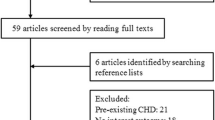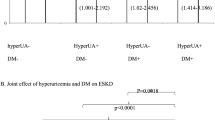Abstract
Background
Hyperuricemia is associated with cardiovascular mortality, but the association of the age at hyperuricemia onset with cardiovascular disease (CVD) and mortality is still unclear.
Objective
The purpose of this study was to examine the associations of hyperuricemia onset age with CVD and all-cause mortality.
Methods
A total of 82,219 participants free of hyperuricemia and CVD from 2006 to 2015 in the Kailuan study were included. The analysis cohort comprised 18,311 new-onset hyperuricemia patients and controls matched for age and sex from the general population. Adjusted associations were estimated using Cox models for CVD and all-cause mortality across a range of ages.
Results
There were 1,021 incident cases of CVD (including 215 myocardial infarctions, 814 strokes) and 1459 deaths during an average of 5.2 years of follow-up. Patients with hyperuricemia onset at an age < 45 years had the highest hazard ratios (HRs) (1.78 (1.14–2.78) for CVD and 1.64 (1.04–2.61) for all-cause mortality relative to controls). The HRs of CVD and all-cause mortality were 1.32 (1.05–1.65) and 1.40 (1.08–1.81) for the 45–54 years age group, 1.23 (0.97–1.56) and 1.37 (1.11 to 1.72) for the 55–64 years age group, and 1.10 (0.88–1.39) and 0.88 (0.76–1.01) for the ≥ 65 years age group, respectively.
Conclusions
The age at hyperuricemia onset was identified as an important predictor of CVD and all-cause mortality risk, and the prediction was more powerful in those with a younger age of hyperuricemia onset.
Graphic abstract
Early onset of hyperuricemia is associated with increased cardiovascular disease and mortality risk.




Similar content being viewed by others
Availability of data and materials
The datasets generated and/or analyzed during the current study are not publicly available, as per internal protocol, but are available from the corresponding author on reasonable request.
Abbreviations
- CVD:
-
Cardiovascular disease
- SUA:
-
Serum uric acid
- MI:
-
Myocardial infarction
- BMI:
-
Body mass index
- eGFR:
-
Estimated glomerular filtration rate
- FBG:
-
Fast blood glucose
- HR:
-
Heart rate
- LDL-C:
-
Low-density lipoprotein cholesterol
- CKD:
-
Chronic kidney disease
References
Xia Y, Wu Q, Wang H, Zhang S, Jiang Y, Gong T et al (2020) Global, regional and national burden of gout, 1990–2017: a systematic analysis of the Global Burden of Disease Study. Rheumatology (Oxford) 59:1529–1538
Liu R, Han C, Wu D, Xia X, Gu J, Guan H et al (2015) Prevalence of hyperuricemia and gout in mainland china from 2000 to 2014: a systematic review and meta-analysis. Biomed Res Int 2015:762820
Krishnan E (2014) Interaction of inflammation, hyperuricemia, and the prevalence of hypertension among adults free of metabolic syndrome: NHANES 2009–2010. J Am Heart Assoc 3:e000157
Kawashima M, Wada K, Ohta H, Terawaki H, Aizawa Y (2011) Association between asymptomatic hyperuricemia and new-onset chronic kidney disease in Japanese male workers: a long-term retrospective cohort study. BMC Nephrol 12:31
Choi HK, Ford ES, Li C, Curhan G (2007) Prevalence of the metabolic syndrome in patients with gout: The Third National Health and Nutrition Examination Survey. Arthritis Rheum-Arthritis Care Res 57:109–115
Rathmann W, Funkhouser E, Dyer AR, Roseman JM (1998) Relations of hyperuricemia with the various components of the Insulin Resistance Syndrome in young black and white adults: The CARDIA study. Ann Epidemiol 8:250–261
Wannamethee SG, Shaper AG, Whincup PH (1997) Serum urate and the risk of major coronary heart disease events. Heart 78:147–153
Fang J, Alderman MH (2000) Serum uric acid and cardiovascular mortality the NHANES I epidemiologic follow-up study, 1971–1992. National Health and Nutrition Examination Survey. Jama 283:2404–2410
Culleton BF, Larson MG, Kannel WB, Levy D (1999) Serum uric acid and risk for cardiovascular disease and death: The Framingham Heart Study. Ann Intern Med 131:7–13
Chen J-H, Chuang S-Y, Chen H-J, Yeh W-T, Pan W-H (2009) Serum uric acid level as an independent risk factor for all-cause, cardiovascular, and ischemic stroke mortality: a chinese cohort study. Arthritis Rheumatism-Arthritis Care Res 61:225–232
Kivity S, Kopel E, Maor E, Abu-Bachar F, Segev S, Sidi Y et al (2013) Association of serum uric acid and cardiovascular disease in healthy adults. Am J Cardiol 111:1146–1151
Zhang W, Iso H, Murakami Y, Miura K, Nagai M, Sugiyama D et al (2016) Serum uric acid and mortality form cardiovascular disease: EPOCH-JAPAN study. J Atheroscler Thromb 23:692–703
Williams B, Mancia G, Spiering W, Rosei EA, Azizi M, Burnier M et al (2018) ESC Scientific Document Group. 2018 ESC/ESH guidelines for the management of arterial hypertension. Eur Heart J 39:3021–3104
Wu Z, Jin C, Vaidya A, Jin W, Huang Z, Wu S, Gao X (2016) Longitudinal patterns of blood pressure, incident cardiovascular events, and all-cause mortality in normotensive diabetic people. Hypertension 68:71–77
Multi-Disciplinary Expert Task Force on Hyperuricemia and Its Related Diseases. [Chinese multi-disciplinary consensus on the diagnosis and treatment of hyperuricemia and its related diseases]. Zhonghua nei ke za zhi. 2017;56:235–248
Jin C, Chen S, Vaidya A, Wu Y, Wu Z, Hu FB et al (2017) Longitudinal change in fasting blood glucose and myocardial infarction risk in a population without diabetes. Diabetes Care 40:1565–1572
Li W, Jin C, Vaidya A, Wu Y, Rexrode K, Zheng X et al (2017) Blood pressure trajectories and the risk of intracerebral hemorrhage and cerebral infarction: a prospective study. Hypertension 70:508–514
Tunstall-Pedoe H, Kuulasmaa K, Amouyel P, Arveiler D, Rajakangas AM, Pajak A (1994) Myocardial infarction and coronary deaths in the World Health Organization MONICA Project. registration procedures, event rates, and case-fatality rates in 38 populations from 21 countries in four continents. Circulation. 90:583–612
Stroke (1989) Recommendations on stroke prevention, diagnosis, and therapy. report of the WHO Task Force on Stroke and other Cerebrovascular Disorders. Stroke. 20:1407–1431
Hou X, Lu J, Weng J, Ji L, Shan Z, Liu J et al (2013) Impact of waist circumference and body mass index on risk of cardiometabolic disorder and cardiovascular disease in Chinese adults: a national diabetes and metabolic disorders survey. PLoS one 8:e57319
Chobanian AV, Bakris GL, Black HR, Cushman WC, Green LA, Izzo JL et al (2003) The seventh report of the joint national committee on prevention, detection, evaluation, and treatment of high blood pressure: the JNC 7 report. JAMA 289:2560–2572
Levey AS, Stevens LA, Schmid CH, Zhang YL, Castro AF, Feldman HI et al (2009) A new equation to estimate glomerular filtration rate. Ann Intern Med 150:604–612
Alberti KG, Zimmet PZ (1998) Definition, diagnosis and classification of diabetes mellitus and its complications. part 1: diagnosis and classification of diabetes mellitus provisional report of a WHO consultation. Diabet med : J B Diabet Assoc 15:539–553
Alberti KG, Eckel RH, Grundy SM, Zimmet PZ, Cleeman JI, Donato KA et al (2009) Harmonizing the metabolic syndrome: a joint interim statement of the international diabetes federation task force on epidemiology and prevention; national heart, lung, and blood institute; american heart association; world heart federation; international atherosclerosis society; and international association for the study of obesity. Circulation 120:1640–1645
Ndrepepa G, Braun S, Haase H-U, Schulz S, Ranftl S, Hadamitzky M et al (2012) Prognostic value of uric acid in patients with acute coronary syndromes. Am J Cardiol 109:1260–1265
Braga F, Pasqualetti S, Ferraro S, Panteghini M (2016) Hyperuricemia as risk factor for coronary heart disease incidence and mortality in the general population: a systematic review and meta-analysis. Clin Chem Lab Med 54:7–15
Kojima S, Sakamoto T, Ishihara M, Kimura K, Miyazaki S, Yamagishi M et al (2005) Prognostic usefulness of serum uric acid after acute myocardial infarction (The Japanese Acute Coronary Syndrome Study). Am J Cardiol 96:489–495
Trkulja V, Car S (2012) On-admission serum uric acid predicts outcomes after acute myocardial infarction: systematic review and meta-analysis of prognostic studies. Croat Med J 53:162–172
Palazzuoli A, Ruocco G, De Vivo O, Nuti R, McCullough PA (2017) Prevalence of hyperuricemia in patients with acute heart failure with either reduced or preserved ejection fraction. Am J Cardiol 120:1146–1150
Zhao G, Huang L, Song M, Song Y (2013) Baseline serum uric acid level as a predictor of cardiovascular disease related mortality and all-cause mortality: a meta-analysis of prospective studies. Atherosclerosis 231:61–68
Chiang KM, Tsay YC, Vincent Ng TC, Yang HC, Huang YT, Chen CH et al (2019) Is hyperuricemia, an early-onset metabolic disorder, causally associated with cardiovascular disease events in han Chinese? J Clin Med 8(8):1202
Chen JH, Hsieh CH, Liu JS, Chuang TJ, Chang HW, Huang CL et al (2016) The power of serum uric acid in predicting metabolic syndrome diminishes with age in an elderly chinese population. J Nutr Health Aging 20:912–917
Feig DI, Johnson RJ (2003) Hyperuricemia in childhood primary hypertension. Hypertension 42:247–252
Feig DI (2012) The role of uric acid in the pathogenesis of hypertension in the young. J Clin Hypertens 14:346–352
Mortada I (2017) Hyperuricemia, type 2 diabetes mellitus, and hypertension: an emerging association. Curr Hypertens Rep 19(9):1–5
Wang C, Yuan Y, Zheng M, Pan A, Wang M, Zhao M et al (2020) Association of age of onset of hypertension with cardiovascular diseases and mortality. J Am Coll Cardiol 75:2921–2930
Sattar N, Rawshani A, Franzen S, Rawshani A, Svensson AM, Rosengren A et al (2019) Age at diagnosis of type 2 diabetes mellitus and associations with cardiovascular and mortality risks findings from the swedish national diabetes registry. Circulation 139:2228–2237
Klisic A, Kocic G, Kavaric N, Jovanovic M, Stanisic V, Ninic A (2018) Xanthine oxidase and uric acid as independent predictors of albuminuria in patients with diabetes mellitus type 2. Clin Exp Med 18:283–290
Kimura Y, Yanagida T, Onda A, Tsukui D, Hosoyamada M, Kono H (2020) Soluble uric acid promotes atherosclerosis via ampk (amp activated protein kinase)-mediated inflammation. Arterioscler Thromb Vasc Biol 40:570–582
Kuwabara M, Kuwabara R, Hisatome I, Niwa K, Roncal-Jimenez CA, Bjornstad P et al (2017) “Metabolically Healthy” obesity and hyperuricemia increase risk for hypertension and diabetes: 5-year japanese cohort study. Obesity 25:1997–2008
Han TS, Meng X, Shan RQ, Zi TQ, Li YM, Ma H et al (2018) Temporal relationship between hyperuricemia and obesity, and its association with future risk of type 2 diabetes. Int J Obesity 42:1336–1344
Fukuoka S, Kurita T, Dohi K, Masuda J, Seko T, Tanigawa T et al (2019) Untangling the obesity paradox in patients with acute myocardial infarction after primary percutaneous coronary intervention (detail analysis by age). Int J Cardiol. 289:12–18
Park SJ, Ha KH, Kim DJ (2020) Body mass index and cardiovascular outcomes in patients with acute coronary syndrome by diabetes status: the obesity paradox in a Korean national cohort study. Cardiovasc Diabetol 19(1):191
Sivera F, Andrés M, Carmona L, Kydd AS, Moi J, Seth R et al (2014) Multinational evidence-based recommendations for the diagnosis and management of gout: Integrating systematic literature review and expert opinion of a broad panel of rheumatologists in the 3e initiative. Ann Rheum Dis 73:328–335
FitzGerald JD, Dalbeth N, Mikuls T, Brignardello-Petersen R, Guyatt G, Abeles AM et al (2020) 2020 American college of rheumatology guideline for the management of gout. Arthritis Care Res (Hoboken) 72:744–760
Acknowledgements
We thank all the survey teams of the Kailuan study group for their contribution and the study participants who contributed their information.
Author information
Authors and Affiliations
Contributions
LLJ, ZMX and XH conceived and designed the study. LLJ, ZMX and WSL contributed to the statistical analysis. LLY and XH drafted the manuscript. All authors contributed to collecting data and reviewed/edited the manuscript for important intellectual content. All authors read and approved the final manuscript.
Corresponding author
Ethics declarations
Ethics approval and consent to participate
This study (ChiCTR-TNC-11001489) was conducted according to the guidelines of the Declaration of Helsinki and was approved by the Ethics Committee of the Kailuan General Hospital. All patients gave written informed consent.
Supplementary Information
Below is the link to the electronic supplementary material.
Rights and permissions
About this article
Cite this article
Li, L., Zhao, M., Wang, C. et al. Early onset of hyperuricemia is associated with increased cardiovascular disease and mortality risk. Clin Res Cardiol 110, 1096–1105 (2021). https://doi.org/10.1007/s00392-021-01849-4
Received:
Accepted:
Published:
Issue Date:
DOI: https://doi.org/10.1007/s00392-021-01849-4




